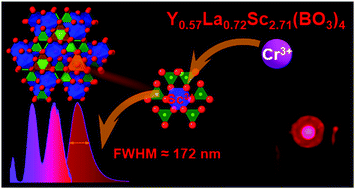Design of broadband near-infrared Y0.57La0.72Sc2.71(BO3)4:Cr3+ phosphors based on one-site occupation and their application in NIR light-emitting diodes†
Abstract
Recently, near-infrared (NIR) phosphor converted light-emitting diodes (pc-LEDs) have attracted much attention due to their applications in the non-destructive detection of the quality of agricultural products and the non-destructive monitoring of human physiological states, which has inspired researchers to develop efficient broadband NIR pc-LED phosphors. To date, the NIR phosphors based on one-site occupation with a relatively large full width at half maximum (FWHM) have rarely been reported. In this work, we have designed a novel NIR Y0.57La0.72Sc2.71(BO3)4:Cr3+ (YLSBO:Cr3+) phosphor with a distorted octahedral crystal structure, which can effectively broaden the Cr3+ emission band. When excited at 466 nm, the emission spectrum ranged from 650 to 1200 nm with a peak maximum at 850 nm and a FWHM of ∼172 nm. At 373 K, the integrated emission intensity of YLSBO:0.025Cr3+ is about 42% of that at room temperature. A NIR pc-LED device was fabricated by combining the as-synthesized YLSBO:0.025Cr3+ phosphor with a 455 nm blue-light-emitting chip. The device can achieve an output power of 17.61 mW at a driving current of 300 mA, which indicates that the as-prepared phosphors have a good prospect for application in NIR pc-LEDs.

- This article is part of the themed collection: Journal of Materials Chemistry C Emerging Investigators


 Please wait while we load your content...
Please wait while we load your content...